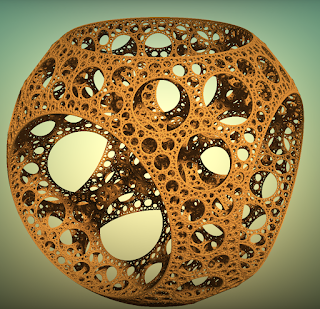What shape is turbulence?
It sounds odd to give the chaotic motion of countless fluid molecules a shape. But we might be able to answer by being a bit broader with our use of the word shape.
We know that turbulence is statistically self-similar so it may fit into one of my structural classes of self-similar shapes. But turbulence is also moving, so we have to look at a 3+1D version of these structural classes. It turns out that mixing temporal and spatial dimensions doesn't have any significant effect on the set of classes, so the 3+1D 'behaviours' are the same classes as the 4D spatial structures. There is a 9x9 table of these.
A solid body of fluid still doesn't have a shape or structure in the conventional sense of a subset of 3+1D. But there are various features in turbulent fluid that we can use to define a shape which is quite consistent over time. The main ones are present in 2D also:
Left is a hyperbolic field, defined by its centre point, magnitude and its two 'invariant' axes. In 3D it is defined by the central line (or curve) and the two intersecting surfaces (a type of 'coherent turbulent structure').
Right is a vortex, defined by its centre point and magnitude, in 3D it is defined by the central vortex line (or curve) and a magnitude.
In 2D all fluid flow is composed of these two features, for example we define the vortex in red and the hyperbolic structure in green here:
The infinitesimal transformation at the vortex is defined by an anti-symmetric matrix (a rotation) and at the hyperbolic point by a symmetric matrix (a nonuniform scale), both are unitary (determinant=1) for incompressible fluids. Halfway between these two matrices are the lower or upper triangular matrices, which represent a shearing action rather than rotation or 'squashing'. This can be our boundary between points inside the 3+1D set and points outside.
In other words, the shape that we are classifying is the set of points in 3+1D whose infinitesimal transform according to the vector field is more anti-symmetric than symmetric. It is the set of points that are in the vortex and not those between vortices.
In 3D vortices look like long limbs, which tend to stretch out over time. Here is a nice image where the vortex curves in a turbulent flow are separated by approximate scale:
This shows the scale symmetry, with many vortices at the small (blue) scale and a few at the large (red) scale.
Even though they look to be distinct curve segments, this is just a threshold on the vorticity, each vortex should extend until it meets another vortex or drops to exactly zero vorticity. So I *think* that most of these curves would connect either to themselves or to the boundary.
That means that the central vortex lines would make something like a void-sponge structure in 3D and therefore either a void-shell or void-foam structure in 3+1D. If we are talking about the solid shape I described above with the thicker vortex limbs, then it would be a sponge in 3D and either a shell or foam in 3+1D.
To further investigate its 3+1D behaviour we need to look at how it behaves. Much of the time these vortices move around but do not interact. They seem to somewhat repel each other. However, there are interactions that occur, such as this:
In 3+1D this is just a single surface in a saddle-like shape. Likewise, it is possible for a ring vortex to appear from nothing, e.g. from a pushed limb of water such as out of a pipe. Again, in 3+1D this looks like a (paraboidal) surface.
So is the structure in 3+1D just a collection of wobbly surfaces? Well, I think that it also has branching, just not very commonly. Firstly, I think there may be branching at the points where the vorticity goes to 0, such as when 4 vortex lines meet in a plane, or where 8 meet as though from the vertices of a cube to the centre. Secondly, we can see examples of a thick vortex limb flattening out and splitting into two thinner limbs:
This is real data, and even shows a second splitting to even smaller vortex limbs:
So the structure can be branching limbs in 3D and therefore branching surfaces in 3+1D. This makes it a shell or a foam.
In
this paper we also see branching happening in the last images, and at a smaller scale. For anti-parallel vortex streams:
and for orthogonal vortex streams:
The difference with a 3+1D foam is that these loops always reconnect back into thicker limbs. With a shell they may branch again and again until they disappear, in terms of turbulence that is descending the energy cascade until the movement becomes thermal energy.
So, all of this considered, I think that there is a good chance that turbulence is a 3+1D shell (specifically a shell-shell), if we are describing the vortex regions. If we describe just the non-vortex regions we will get the set complement of the shell-shell in 3+1D, which is in fact also a shell-shell.
And none of this is affected by how thick we make the vortices, so we needn't necessarily stop at the 'shear surface'. What we can't do is use the 'vortex surface' used in many visualisations because this is based on a fixed vorticity value, so it disconnected and therefore looks more like blobs than a connected sponge-like structure in 3D.
Incidentally, there is also
a lot to be said about knots in turbulent vortices, but it doesn't matter for the 3+1D structural class because a knotted string in 3D is not a knotted surface in 3+1D.























































